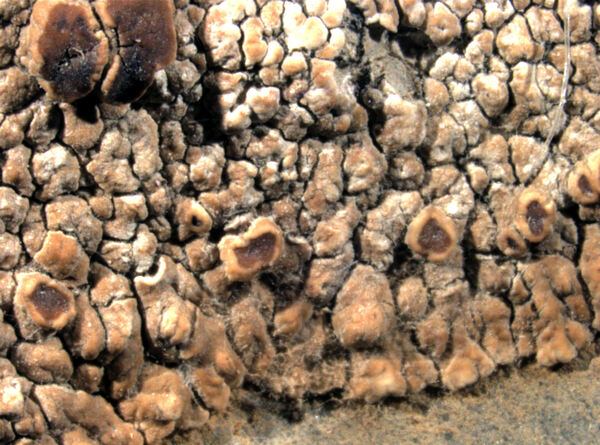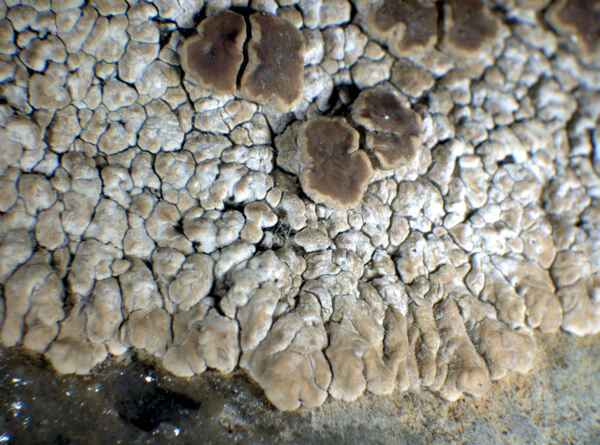Lecanora diaboli Frey & Poelt
in Poelt, Mitt. bot. Staatss. München, 19-20: 490, 1958.
Synonyms: Lecanora concolor Ramond f. elata (Arnold) Mig.; Placodium concolor (Ramond) Körb. f. elatum Arnold
Distribution:
Description: Thallus crustose-placodioid, episubstratic, yellowish green, sometimes weakly pruinose, up to 5(-8) mm thick, forming orbicular rosettes. Central parts of thallus rimose-areolate, with 0.5-2 mm wide, flat to bullate areoles; marginal lobes contiguous, 2-5 mm long, convex, thinner and flattened at apex. Upper cortex 70-150 µm thick, with small yellowish grey granules; medulla chalky white, filled with coarse granules; algae arranged in clusters. Apothecia lecanorine, broadly adnate, 1-2(-3) mm across, with an initially flat, then slightly to strongly convex, ochraceous brown disc, and a rather thick, but finally often excluded thalline margin. Epithecium pale brown, scarcely differentiated from hymenium; hymenium colourless, 60-75 µm high; paraphyses sparingly branched and anastomosing, slightly thickened at apex; hypothecium colourless, 70-100 µm high. Asci 8-spored, clavate, very thin-walled, with a K/I+ blue, tall tholus penetrated by a faintly amyloid apical cushion, the wall K/I-, surrounded by a blue outer layer, Lecanora-type. Ascospores 1-celled, hyaline, ellipsoid, 8-12 x 4.5-6 µm. Photobiont chlorococcoid. Spot tests: thallus K- or K+ indistinctly brownish yellow, C-, KC+ pale yellow, P-. Chemistry: cortex with usnic acid.Note: on steeply inclined surfaces of marly limestone or schists and even gneiss in the alpine belt. Never reported from Italy, but known form adjacent areas; to be looked for in the Alps.
Growth form: Crustose placodiomorph
Substrata: rocks
Photobiont: green algae other than Trentepohlia
Reproductive strategy: mainly sexual

Predictive model
Growth form: Crustose placodiomorph
Substrata: rocks
Photobiont: green algae other than Trentepohlia
Reproductive strategy: mainly sexual

Predictive model
 Index Fungorum
Index Fungorum
 GBIF
GBIF




